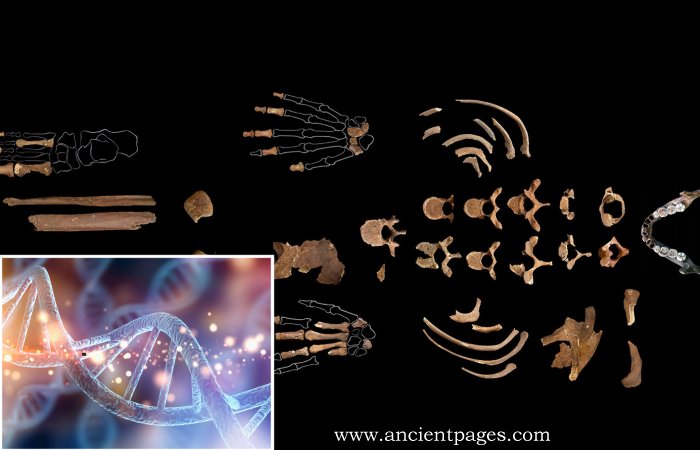Jan Bartek – AncientPages.com – Approximately 19,000 years ago, a woman from a hunter-gatherer community passed away and was interred in a cave located in northern Spain. In 1996, archaeologists began investigating this site, uncovering substantial evidence of prehistoric human activity.
Red Lady’s skeleton. Credit: University of New Mexico
In 2010, Lawrence Straus, an Emeritus Leslie Spier Distinguished Professor at The University of New Mexico, along with Spanish student David Cuenca Solana, discovered the woman’s remains. This discovery occurred after Straus decided to excavate behind an engraved block at the rear of El Mirón Cave’s large vestibule—a site he and his colleague Professor Manuel Gonzalez Morales from Universidad de Cantabria have been exploring for over 25 years.
The woman was estimated to be between 35 and 40 years old at her time of death. Her bones were covered with ochre—a red pigment not native to the area—containing specular hematite that gave it a sparkling appearance. This unique feature led to her being named “the Red Lady of El Mirón.” Since this discovery, she has provided archaeologists and bioanthropologists with remarkable insights.
Traditionally in archaeology and DNA studies, genetic material is extracted from bones or teeth found within human remains; this was true for the Red Lady as well. However, groundbreaking research now also utilizes DNA extracted from soil—known as sedimentary ancient DNA or “sedaDNA”—which has unveiled new details about both human and animal populations that existed before the era of the Red Lady of Mirón.
An article titled “A sedimentary ancient DNA perspective on human and carnivore persistence through the Late Pleistocene in El Mirón Cave, Spain” has been published in Nature Communications. This research was conducted by a team led by Pere Gelabert and Victoria Oberreiter from Professor Ron Pinhasi’s lab at the Department of Evolutionary Anthropology, University of Vienna, Austria. About three years ago, Professor Ron Pinhasi approached Straus to explore sedaDNA analysis at El Mirón Cave. Straus contributed archaeological, chronological, and faunal data as well as references for this study and authored supplementary material for the paper. The research involved extracting human and animal mitochondrial DNA from sediments found in the site’s lower levels.
“We don’t need bones,” Straus said. “The results show that several animals not represented by bones from the dig were present—either once living in the cave or as carcass pieces—in the past and, importantly, the humans who made the Solutrean artifacts during the height of the Last Glacial Maximum (about 25,000 to 21,000 years ago) had ‘Fournol’ genetic ancestry, as has been found in bones or teeth from sites in France and Spain (including La Riera in Asturias, a site dug by Straus in the 1970s).
Sampling procedure on the rear vestibule of the Cave. Credit: Nature Communications (2025). DOI: 10.1038/s41467-024-55740-7
“These were the people whose range had contracted southward during the climatic crisis and who preceded the Red Lady of El Miron and contributed to her DNA, along with DNA of Villabruna ancestry derived from humans whose genes had come to Cantabrian Spain in Lower Magdalenian times from the Balkans via northern Italy.”
The ability to extract DNA from dirt makes it much more possible to study ancient animals and humans, since bones with well-preserved DNA, especially from humans, are rare.
“As with everything else at El Miron DNA-wise, the preservation of DNA in dirt here is extraordinary. We now know who the predecessors of the Red Lady were, confirming evidence from other sites with DNA from bones and teeth.”
SedaDNA analysis reveals the presence of various carnivores and ungulates at El Mirón, including species like the dhole—a wild dog now limited to eastern and southeastern Asia—as well as leopards, hyenas, woolly mammoths, rhinoceroses, and reindeer. These findings are significant because they identify species that are either scarcely or not at all represented by the bones previously discovered by archaeologists. The sedaDNA evidence spans a timeline from over 46,000 years ago during Mousterian-Neanderthal times to the Initial Magdalenian period around 21,000 to 20,000 years ago.
See also: More Archaeology News
“This is another methodological and empirical breakthrough, like the DNA research on natural products that may have therapeutic value from bacteria preserved in the Red Lady’s dental calculus published in Science by Warinner, Pierre Stallforth, Martin Klapper and colleagues in Jena,” Straus said.
“Meanwhile, we continue to publish on the basic archaeology of El Mirón—the seasonality of human occupations from the animals that they hunted, which is determined from teeth and bone development, stone tools, bone tools such as needles, and weapons such as points.”
The study was published in the journal Nature Communications
Written by Jan Bartek – AncientPages.com Staff Writer










